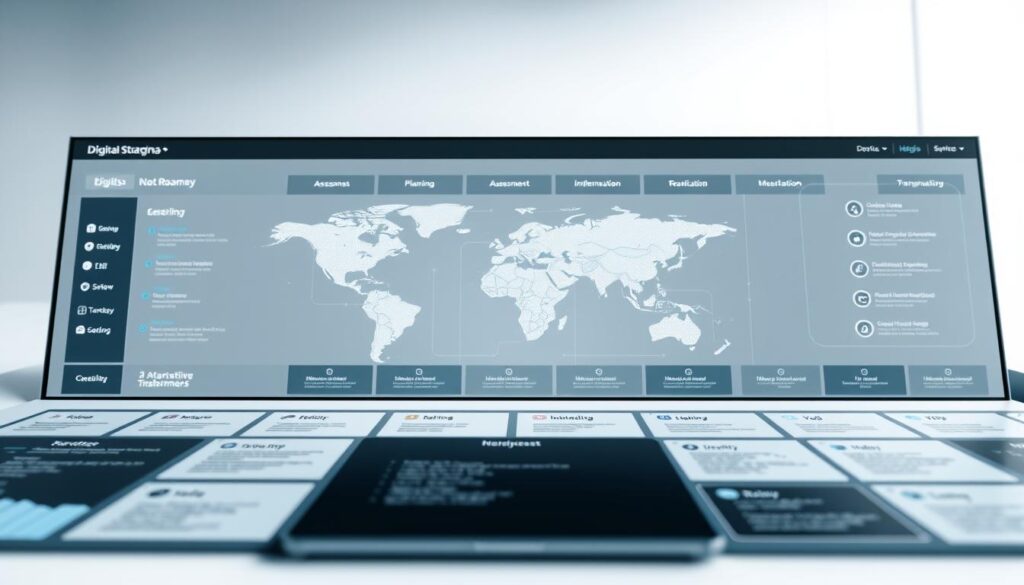Today’s businesses need to keep up with the fast digital world. digital transformation is not just a trend; it’s essential to stay ahead. By using business technology, companies can make things run smoother, connect with customers better, and innovate quicker than ever.

A dynamic landscape of digital transformation strategies, showcasing interconnected gears, circuits, and data streams. In the foreground, a central gear mechanism represents the core of the transformation, surrounded by intricate technological elements such as microchips, wires, and holographic interfaces. The middle ground features a cityscape of futuristic skyscrapers and infrastructure, symbolizing the integration of digital solutions into the business landscape. The background displays a vibrant, colorful aurora-like energy field, hinting at the innovative and forward-thinking nature of the digital transformation process. The scene is illuminated by a warm, ambient lighting that casts a sense of progress and optimism. Captured through a wide-angle lens, the image conveys a comprehensive view of the digital transformation strategies at play.
Whether you’re a small startup or a big company, digital transformation can help. It can cut costs, make things more efficient, and open up new ways to make money. It’s about using tools like cloud computing, AI, and data analytics to turn problems into chances .
Key Takeaways
- Adopting digital transformation drives growth and innovation in all industries.
- Business technology solutions improve customer interactions and operational speed.
- Companies that ignore digital progress risk falling behind competitors.
- Successful digital transformation requires clear goals and strategic planning.
- Investing in business technology today secures long-term success and adaptability.
Understanding Digital Transformation in Today’s Business Landscape
Success in today’s business world depends on keeping up with fast-changing tech. Digital transformation is more than just a trend—it’s a must for staying ahead. Let’s explore what it means for your business.
The Evolution of Business Technology
Business tech has changed a lot over the years. Here’s a quick look:
| Decade | Key Technology | Impact |
|---|---|---|
| 1950s-1980s | Mainframe computers | Automated record-keeping |
| 1990s-2000s | PCs, internet | Global connectivity |
| 2010s-Present | AI, cloud computing | Smart systems driving growth |
Why Digital Transformation Matters Now More Than Ever
“Digital transformation isn’t optional—it’s essential for survival.” – Industry analyst report, 2023
- Customers want services right away
- New tech startups are everywhere
- The world expects businesses to be quick
Key Components of Successful Digital Transformation
- Modern business technology infrastructure
- Processes made more efficient
- Training employees to use new tech
- Matching tech spending with business goals
Companies like Netflix and Walmart have shown success. They mix these elements for innovation. Start small, but dream big.
The Business Impact of Effective Digital Transformation
Companies that adopt digital transformation see real benefits. They become more efficient thanks to business technology that simplifies tasks. For example, Walmart sped up delivery times by using real-time data analytics.
“Digital disruption isn’t optional—it’s a survival strategy in today’s market.” — McKinsey & Company
- Cost Reduction: Airlines like Delta cut overhead by 15% with cloud-based systems.
- Customer Retention: Banks using AI chatbots saw a 20% boost in satisfaction.
- Revenue Growth: Netflix’s streaming model disrupted TV, earning over $30B annually.
Digitally transformed businesses open up new ways to make money. Healthcare providers now offer telemedicine, making care more accessible and affordable. Meanwhile, manufacturers use IoT sensors to predict equipment failures, reducing downtime by 30%.
These changes are not just trends; they show digital disruption drives innovation. Companies that adapt first gain an edge, leaving competitors behind. Investing in business technology today means securing a strong future.
Common Obstacles on Your Digital Transformation Journey
Every digital transformation journey has its hurdles. These can range from outdated processes to limited resources. It’s crucial to plan ahead and tackle these challenges early on.
Organizational Resistance to Change
Cultural inertia can slow down progress. Teams used to traditional ways might not want to change. Leaders need to build trust by:
- Explaining the long-term benefits of organizational change
- Getting employees involved in decisions
- Sharing success stories of early adopters
Technology Integration Challenges
Old systems often don’t work well with new tech. Issues include:
- Data silos that stop teams from working together
- Problems with old and new systems working together
- Risks to security during the transition
Budget Constraints and ROI Concerns
High costs can be a problem, especially when there’s pressure for quick results. To overcome this, consider:
- Implementing new tech in phases to manage costs
- Focusing on the most important uses first
- Tracking small wins along the way
Talent and Skill Gaps
Teams might not have the right skills for new tech. To address this, you can:
- Work with training providers like Coursera or LinkedIn Learning
- Set up mentorship programs
- Hire experts to fill knowledge gaps
These challenges are common, but they can be overcome. With proactive planning, obstacles become stepping stones to successful digital transformation.
Building a Comprehensive Digital Strategy for Your Organization
Every organization’s journey to digital transformation begins with a clear plan. A well-designed digital strategy aligns technology upgrades with business goals. It turns challenges into growth opportunities.
Conducting a Digital Readiness Assessment
Start by checking your organization’s current state. Look at infrastructure, employee skills, and data systems. This helps find strengths and areas for improvement. Use tools like SWOT analysis or third-party audits to guide your efforts.

A detailed digital strategy roadmap displayed on a sleek, modern dashboard. The foreground shows a series of interactive tiles depicting various stages of the strategy, such as assessment, planning, implementation, and review. The middle ground features a stylized world map, highlighting global connectivity and the reach of the digital transformation. The background showcases a minimalist, yet sophisticated color palette of grays, blues, and subtle accents, creating a professional and aspirational atmosphere. The lighting is soft and diffused, emphasizing the clarity and focus of the roadmap. The camera angle is slightly elevated, providing a comprehensive view of the digital strategy landscape.
| Factor | Current Status | Improvement Steps |
|---|---|---|
| Technology Infrastructure | Legacy systems | Upgrade to cloud-based tools |
| Data Management | Limited analytics tools | Adopt AI-driven analytics platforms |
| Employee Skills | Basic digital literacy | Launch training programs |
Setting Clear Transformation Goals
A strategy without measurable goals is like a ship without a compass.
Set goals that align with business outcomes. For instance, a retail business might aim to cut operational costs by 15% through automation. Break down goals into short-term milestones to track progress.
Creating Your Digital Transformation Roadmap
- Phase 1: Address immediate needs (e.g., cybersecurity updates)
- Phase 2: Integrate customer-facing tools (e.g., mobile apps)
- Phase 3: Optimize backend processes
Assign timelines and resources for each phase. Regular reviews help adapt to technology or market changes.
Remember: A flexible digital strategy evolves with your digital transformation. Start small, learn fast, and scale your successes.
Leveraging Data-Driven Decision Making
Today’s businesses do best when they make choices based on facts, not guesses. A data-driven strategy turns numbers into useful insights. This helps drive digital transformation at every step. It makes data a key asset for innovation and efficiency.
First, data is collected. Companies get info from customers, sales, and operations. Tools like real-time analytics and AI dashboards make this data easy to see. For instance, predictive analytics help spot market changes early.
- Track customer behavior through website analytics and CRM systems.
- Use cloud-based platforms to unify data from multiple sources.
- Implement automation tools to process large datasets quickly.
To build a data-focused culture, teams need to learn analytics. Regular training and teamwork help everyone use data to meet goals. Being open about how data influences decisions builds trust.
Keeping data safe is also key. Strong rules ensure data privacy laws are followed. Companies must innovate responsibly to keep customer trust.
Technology Implementation: Choosing the Right Solutions for Your Needs
Choosing the right business technology is key to a successful digital transformation. The right tools make operations smoother, increase agility, and meet your goals. Here’s how to make the best choices.

A dynamic technology implementation strategy, showcasing innovative solutions for digital transformation. In the foreground, a team of professionals collaborate on a holistic plan, discussing cutting-edge software and hardware integrations. The middle ground depicts a sleek, futuristic control panel with interactive data visualizations, highlighting key metrics and KPIs. In the background, a bustling office environment with state-of-the-art workstations and collaborative spaces, reflecting a culture of constant innovation. Vibrant colors, sharp contrasts, and a sense of forward momentum convey the energy and excitement of embracing new technologies. Dramatic lighting from multiple angles accentuates the high-tech atmosphere, creating a visually striking scene that captures the essence of strategic technology implementation.
Moving to cloud platforms updates your setup and saves money. Look into these options:
| Option | Cost Structure | Scalability | Best For |
|---|---|---|---|
| Public Cloud | Pay-as-you-go | High | Startups, variable workloads |
| Private Cloud | Fixed costs | Moderate | Regulated industries |
| Hybrid Cloud | Mixed | Custom | Large enterprises |
Automation and AI Integration
- Automate repetitive tasks with RPA (Robotic Process Automation)
- AI tools like chatbots improve customer service and data analysis
- Machine learning models predict trends and reduce errors
Customer Experience Technologies
Invest in CRM systems and omnichannel platforms to unify customer interactions. Tools like Salesforce or Zendesk enhance personalization and loyalty programs.
Cybersecurity Considerations
Data encryption, multi-factor authentication, and compliance with GDPR/PCI-DSS are critical. Build security into every phase of technology implementation to avoid breaches.
Align choices with your team’s skills and long-term vision. The right tech stack turns innovation into tangible results.
Fostering a Culture of Digital Innovation
Successful innovation begins with a mindset shift. Organizations must focus on organizational change. This change empowers employees to be part of the transformation. Leaders should show curiosity and share challenges openly. They should also celebrate small wins to build trust.
- Encourage experimentation by rewarding creative solutions—even if ideas fail.
- Establish cross-departmental teams to break down silos and amplify diverse perspectives.
- Adopt agile frameworks to shorten feedback loops and speed up decision-making.
Innovation happens when people feel empowered to question the status quo.
—Harvard Business Review, 2023
Regular workshops and training sessions help employees adapt to new tools. They also reinforce the company’s vision. Companies like Adobe and IBM have seen great results. They outperform peers by 26% in customer satisfaction and 12% in revenue growth, according to Deloitte reports.
Start small: pilot new processes with a team, then scale successes. By focusing on people, organizations can make organizational change a key driver of success.
Case Studies: Digital Transformation Success Stories
See how companies in different fields are making digital transformation work. From small startups to big corporations, these stories show how embracing digital trends can lead to growth and new ideas.

A sleek, modern office space with large windows overlooking a bustling city skyline. In the foreground, a team of professionals gathered around a conference table, deep in discussion, their laptops and tablets displaying various data visualizations and project management dashboards. The middle ground features a large, interactive touchscreen display showcasing a timeline of successful digital transformation case studies, with icons and illustrations highlighting key milestones and achievements. The background is filled with a vibrant, energetic atmosphere, with employees collaborating at standing desks and the occasional robot or autonomous device gliding through the space, reflecting the cutting-edge technology that enables the digital transformation. Soft, warm lighting illuminates the scene, creating a sense of productivity and innovation.
Small Business Transformation Examples
A small bookstore, Quarry Books, saw a 35% increase in sales with an online app. Blue Apron also used online sales to become a top meal-kit service. These examples show even small businesses can succeed with digital strategies.
Enterprise-Level Digital Disruption
Big names like Nike changed their game by focusing on mobile apps. Their NIKE App now handles 40% of all customer interactions, mixing online and in-store experiences.
Industry-Specific Transformation Insights
Mayo Clinic grew its telehealth services by 200% in 2023. Walmart also made a big change by using AI to manage inventory, cutting restock times by 30%.
| Industry | Company | Strategy | Result |
|---|---|---|---|
| Healthcare | Mayo Clinic | Telehealth platform | 200% telehealth visit increase |
| Retail | Walmart | AI inventory systems | 30% faster restocking |
| Manufacturing | Siemens | IoT-enabled factories | 15% cost reduction |
Every field has its own success story. Whether it’s improving supply chains or making customer experiences better, these examples show the impact of digital transformation.
Measuring the Success of Your Digital Transformation Initiatives
Tracking progress is key to proving the value of digital transformation. Without clear metrics, it’s hard to show how tech changes boost business results. Start by focusing on what truly matters to your goals.
Key Performance Indicators to Track
- Financial gains: Track cost savings, revenue lifts, and profit margins.
- Customer metrics: Monitor satisfaction scores and retention rates.
- Operational health: Measure efficiency improvements like faster processes.
Continuous Improvement Strategies
Use a data-driven strategy to refine efforts. Regular check-ins and feedback loops help spot trends early. Adjust plans based on real-world results, not assumptions.
Long-Term ROI Evaluation
Look beyond short-term wins. Assess how digital transformation builds future readiness. Metrics like market share growth or talent development show long-term value.
Remember, success isn’t a one-time check. Keep iterating, learning, and adapting. The right data helps turn vague goals into measurable wins everyone can see.
Conclusion: Embracing Digital Transformation as a Continuous Journey
Digital transformation is a never-ending journey for businesses. It shapes how they adapt to change. A clear digital strategy is key, blending technology, culture, and innovation to stay ahead.
Every step, from using AI tools to training teams, moves them closer to their goals.
Companies like Amazon and Netflix lead by making innovation a part of their daily work. Their success shows how digital strategies can turn challenges into chances. Even small steps in cloud computing or customer experience tech can make a big difference for health tips.
Progress begins with taking the next step, whether it’s refining a digital roadmap or trying new tools. Tools like automation or cybersecurity solutions help grow efforts without overloading teams.
The journey ahead requires curiosity about trends like 5G or AI. Being open to innovation helps businesses keep up with the market. Digital transformation is about moving forward, not being perfect. It’s about taking one step at a time.
FAQ
What is digital transformation?
Digital transformation means using digital technology in all parts of a business. It changes how a business works and serves customers. It often uses data and new tech to make things better and improve customer service.
Why is digital transformation important for my business?
Digital transformation keeps your business ahead in today’s fast world. It makes operations more efficient, helps respond to market changes, and meets customer needs. This leads to growth and new ideas.
What are the key components of a successful digital strategy?
A good digital strategy needs strong tech, a clear vision, an innovative culture, and data analysis. These parts help use technology well and solve problems.
How can I measure the success of my digital initiatives?
Track KPIs like revenue, cost savings, and customer happiness. Also, look at long-term benefits and keep improving. This shows if digital efforts are working.
What challenges might I face during digital transformation?
You might face resistance, tech issues, budget limits, and talent gaps. Knowing these challenges helps plan how to deal with them.
How can data drive my digital transformation initiatives?
Data helps make smart decisions and improve digital plans. It finds new ways to innovate and work better, helping meet business goals.
What role does company culture play in digital transformation?
Culture is key for success. A culture that supports innovation, teamwork, and quick adaptation helps with change and new tech.
How can I get started with building my digital transformation roadmap?
Start with a tech readiness check to see what you need. Set goals that match your business and make a detailed plan. This plan should include what to do first, when, and who will do it.
What technologies should I consider for my digital transformation?
Look at cloud, automation, AI, and customer solutions. Choosing the right tech is important for a smooth transformation.
Can small businesses benefit from digital transformation as well?
Yes! Small businesses can use digital transformation to work better, serve customers better, and compete well. They can make a big impact with less money.


DzFpoRWS EaCXAc VayKN DzKgQ
Fascinating analysis! Shooting Games offers intense action. Shooting Games delivers excitement through realistic graphics and thrilling gameplay.